|
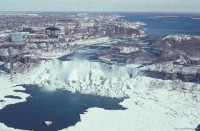
American Falls taken from Skylon Tower. February, 1999

Horseshoe Falls from Skylon Tower. February, 1999
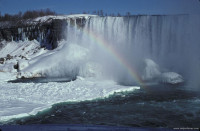
Rainbow in front of American Falls. February, 1999
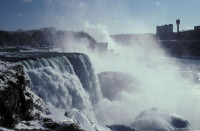
American Falls. February, 1999
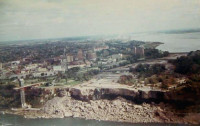
Photograph of American Falls “turned off” during 1969 to clear the eroded rock at the base of the Falls. You can see the upper caprock of limestone and dolostone exposed not only in the caprock but in the debris below the Falls.

In 1911, Bobby Leach became only the second person to go over Niagara Falls in a barrel. He spent six months in the hospital from many broken bones after the tumultuous trip.
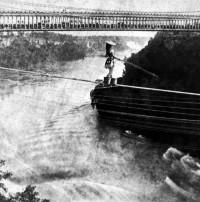
Maria Spelterini crossing over Niagara Gorge near Niagara Falls on a tight rope on July 8, 1876.
Niagara Falls consists of two major falls – Horseshoe Falls on the Canadian side of the border and American Falls which are separated by Goat Island (Bridal Veil Falls is very close to American Falls and is often considered part of the American Falls). The Niagara River flows over the falls passing from Lake Erie to Lake Ontario. Nearly 6 million cubic feet of water (168,000 cubic m) flows over the falls during periods of high flow.
Niagara Falls has moved progressively toward Lake Erie (about 11,000 years ago, Niagara Falls was located in the Lewiston, NY, area). The reason for the recession is related to erosion. There is a hard caprock that the river flows over consisting of limestone and dolostone. But as the water flows over the Falls, it erodes the softer rock (primarily shale) below the caprock. With time, the caprock collapses as the shale is eroded away from below. In 1969, they rerouted the water from American Falls to Horseshoe Falls to clear the rocks that had built up at the base of the falls from the erosion. They also reinforced fractures to slow the erosion. In thousands of years, Niagara Falls will eventually erode into Lake Erie which will then empty into Lake Ontario in a spectacular flood.
There are several other noteworthy aspect of Niagara Falls. Hydroelectric power is generated from the Falls for both Canada and the United States. The Falls have also acted as a magnate for various crackpots and publicity seekers. As far back as 1901, the first person went over the Falls in a barrel – 63-year old Annie Edson Taylor – and survived. As many as 14 people have intentionally gone over the Falls, many died or were severely injured. It is now illegal to do so. In 1960, a seven-year old boy protected only by a life vest was accidently swept over the falls and miraculously survived. In 2003, a man went over the Falls without any protection and survived. It is still unknown if it was a suicide attempt or not. Since then, several other people have survived similar plunges.
Many people have tried to cross the Niagara Gorge on a tight rope. It was first accomplished by Jean François "Blondin" Gravelet in 1859. A large number of people have accomplished the feat even as recently as 2012. Only one person has died in an attempt.
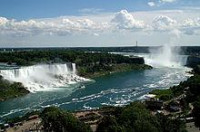
Niagara Falls (Cayuga: Gahnawehtaˀ or Tgahnawęhtaˀ) is the collective name for three waterfalls that straddle the international border between the Canadian province of Ontario and the U.S. state of New York. They form the southern end of the Niagara Gorge.






 Please share your ideas with us.
Please share your ideas with us.